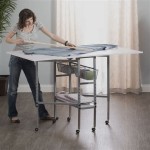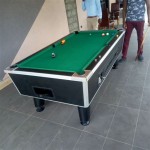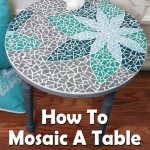Understanding the Appeal of Rustic Cast Iron Table Legs
Rustic cast iron table legs have experienced a surge in popularity, driven by a desire for durable, aesthetically pleasing, and historically resonant furniture design. These legs offer a blend of industrial strength and vintage charm, making them a preferred choice for both DIY enthusiasts and professional furniture makers seeking to create unique statement pieces. The inherent qualities of cast iron, coupled with the intentional design choices that emphasize a rustic aesthetic, contribute to the enduring appeal of these table legs.
The term "rustic" in this context refers to a style that emphasizes natural materials and a sense of age and authenticity. This often translates to textures that are less refined, surfaces that display variations in color and finish, and designs that evoke a sense of history. When applied to cast iron, this aesthetic can manifest in several ways, including visible iron casting marks, intentional imperfections, and finishes designed to mimic the patina of aged metal.
Cast iron, as a material, offers a distinct set of advantages. It is known for its exceptional strength and stability, capable of supporting heavy loads. This makes it well-suited for tables of various sizes and intended uses, from dining tables and coffee tables to workbenches and console tables. Furthermore, cast iron is relatively resistant to warping and bending, ensuring that the table remains stable over time. The material's inherent weight also contributes to the table's stability, preventing unwanted movement or tipping.
Beyond their structural benefits, rustic cast iron table legs contribute significantly to the overall aesthetic of a piece of furniture. They can transform a simple tabletop into a visually compelling focal point, adding character and a sense of history to the space. The contrast between the raw, industrial feel of the iron and the natural warmth of a wooden tabletop, for example, can create a striking and balanced design.
Durability and Longevity: The Foundation of Rustic Cast Iron
One of the primary reasons for selecting cast iron table legs is their exceptional durability. Unlike materials such as wood or steel tubing, cast iron possesses a high degree of inherent strength. This allows it to withstand significant weight and stress without deforming or failing. The robust nature of the material makes it an ideal choice for tables that are intended for heavy use or that will be exposed to potentially damaging conditions.
The longevity of cast iron is another significant advantage. When properly cared for, cast iron can last for generations. Its resistance to corrosion, while not absolute, is generally superior to that of other common metals used in furniture construction. Modern sealing and coating techniques can further enhance this resistance, protecting the iron from rust and other forms of degradation. The inherent durability and longevity of cast iron contribute to the sustainability of the furniture, reducing the need for frequent replacement and minimizing environmental impact.
Furthermore, cast iron is relatively resistant to impacts and scratches. While surface imperfections can occur, they often add to the rustic charm of the piece, contributing to its sense of age and authenticity. The material's ability to withstand wear and tear makes it a practical choice for tables that are likely to be subjected to heavy use or accidental damage.
The manufacturing process of cast iron also contributes to its strength. Molten iron is poured into a mold, allowing it to solidify into the desired shape. This process creates a solid, homogenous structure that is free from welds or seams, which can be points of weakness in other types of metal furniture legs. The absence of these weak points enhances the overall strength and stability of the table legs.
The weight of cast iron, while sometimes perceived as a disadvantage, is actually a contributing factor to its durability and stability. The heavy weight helps to anchor the table, preventing it from tipping or shifting during use. This is particularly important for larger tables or tables that are likely to be subjected to heavy loads. The weight also provides a sense of solidity and quality, enhancing the overall impression of the furniture.
Aesthetic Versatility: Blending Rustic Charm with Modern Design
Despite its association with a specific aesthetic, rustic cast iron table legs offer a surprising degree of versatility in design. They can be seamlessly incorporated into a wide range of interior styles, from farmhouse and industrial to modern and eclectic. The key to successful integration lies in carefully selecting the right leg design and finish to complement the surrounding décor.
For farmhouse-style interiors, cast iron legs with a simple, understated design and a matte black or dark brown finish are often a good choice. These legs can be paired with a reclaimed wood tabletop to create a warm and inviting atmosphere. The contrast between the rough texture of the wood and the solid presence of the iron creates a visually appealing balance.
In industrial-style spaces, more elaborate cast iron designs with visible bolts, rivets, and other industrial-inspired details can be incorporated. These legs often feature a raw, unfinished look or a clear coat that allows the natural color and texture of the iron to shine through. They can be paired with a concrete or metal tabletop to create a cohesive and edgy aesthetic.
Even in modern interiors, rustic cast iron table legs can find a place. By choosing a design with clean lines and a minimalist aesthetic, the legs can add a touch of industrial chic to a contemporary space. They can be paired with a glass or acrylic tabletop to create a striking contrast between the old and the new.
The finish of the cast iron is also an important consideration. Matte black, dark brown, and raw iron finishes are commonly associated with the rustic aesthetic. However, other finishes, such as antique bronze or brushed silver, can also be used to create a unique and stylish look. The choice of finish should be based on the overall color palette and style of the room.
The shape and size of the table legs can also influence their overall aesthetic. Simple, straight legs are generally more versatile and can be used in a wider range of settings. More elaborate designs, such as those with curved legs or decorative details, can add a touch of elegance and sophistication. The size of the legs should be proportional to the size of the tabletop to ensure a balanced and visually appealing design.
Customization and DIY Potential: Creating Unique Furniture Pieces
Rustic cast iron table legs are particularly appealing to DIY enthusiasts and those seeking to create custom furniture pieces. The availability of a wide range of leg designs, sizes, and finishes allows for a high degree of customization. This enables individuals to create tables that perfectly match their specific needs and aesthetic preferences.
One of the most popular DIY projects involving cast iron table legs is the creation of a custom dining table. By sourcing a reclaimed wood tabletop or building one from scratch, individuals can create a unique and personalized dining experience. The cast iron legs provide a sturdy and stylish foundation for the tabletop, ensuring that the table is both functional and aesthetically pleasing.
Another common DIY project is the creation of a custom coffee table. Cast iron legs can be paired with a variety of tabletops, including wood, glass, and stone, to create a unique and eye-catching centerpiece for the living room. The legs can be chosen to complement the existing décor or to create a striking contrast.
Cast iron table legs can also be used to create custom desks, benches, and console tables. The possibilities are virtually endless, limited only by the imagination of the DIY enthusiast. The ease of installation and the availability of a wide range of leg designs make it possible to create professional-looking furniture pieces without specialized tools or skills.
The ability to customize the finish of the cast iron legs further enhances the DIY potential. The legs can be painted, stained, or treated with a variety of finishes to achieve the desired look. This allows individuals to create furniture pieces that perfectly match their existing décor or to experiment with unique and unconventional finishes.
The process of attaching the cast iron legs to the tabletop is typically straightforward, involving the use of screws or bolts. Detailed instructions are often provided by the manufacturer, and online resources are readily available to assist with the installation process. With a little bit of effort and creativity, anyone can create a stunning and personalized furniture piece using rustic cast iron table legs.

16 5 Tall Cast Iron Bench Coffee Table Legs 2 Pack Industrial Embossed Rustic Cincinnati Live Edge Reclaimed Bases Wood Granite

29 Cast Iron Dining Table Base In Black With Jcs Embossment Legs 2 Pack Casting Company Bases

34 Cast Iron Counter Height Table Legs In Rustic Black Jcs Casting Company Bases

28 Dining Table Desk Height Industrial Cast Iron Legs Base Los Angeles

28 Cast Iron Dining Table Base In Rustic Chrome With Plymouth Mass Embossment Trestle Jcs Casting Company Bases Legs

Cast Iron Bench Coffee Table Legs 2 Pack Industrial Embossed Rustic Jcs Casting Co Live Edge Reclaimed Bases Wood Granite

28 Rustic Finish Wishbone Cast Iron Dining Table Legs Desk Base

34 Cast Iron Counter Island Table Base In Rustic Red With Cincinnati Embossment Jcs Casting Company Bases Legs

Cast Aluminum Table Legs Metal With Without Bench Wishbone Style

B8c5 Ornamental Line Cast Iron Table Base Peter Meier Inc








